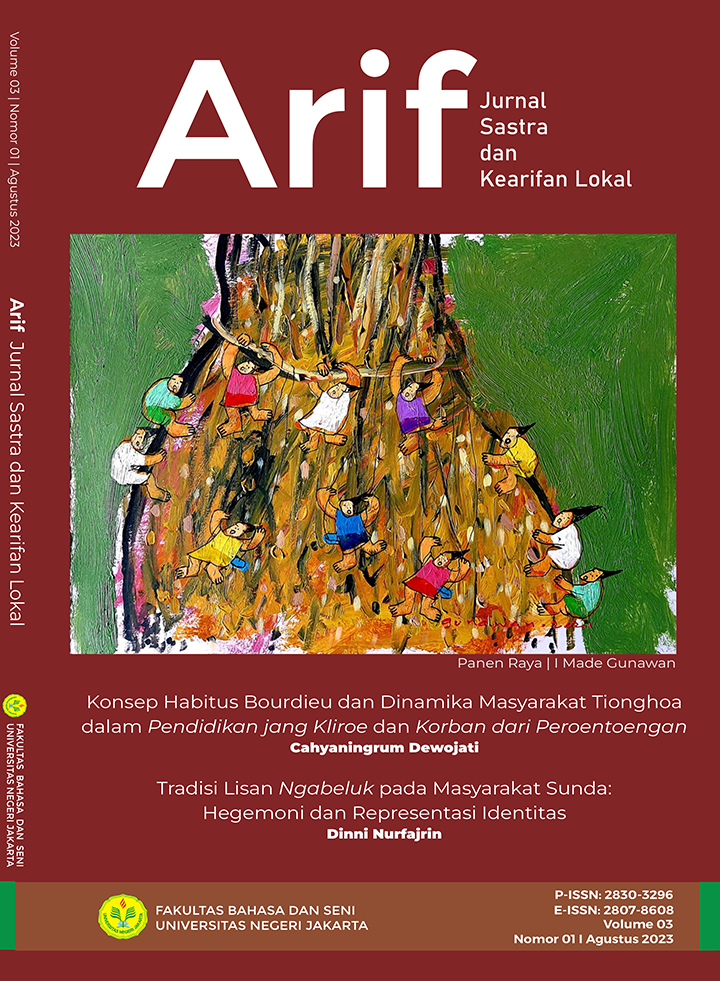Masculinity and Femininity Symbols in South China Buddhist Temples: Psycho-Anthropological Perspective
DOI:
https://doi.org/10.21009/Arif.031.05Keywords:
anthropology, femininity, masculinity, psycho-anthropology, Quan YinAbstract
Studies on masculinity in the last ten years have increased along with men's awareness of themselves. The study of masculinity is in opposition to the study of femininity. In this regard, this research intersects both of them, namely the study of masculinity and femininity in the Quan Yin temple in China. This research explores the Quan Yin symbols in the Southern Chinese (Mahayana Buddhist) Temples. This study uses a psycho-anthropological perspective. This research with a qualitative approach uses data from the architecture of the Quan Yin Temple. Data collection techniques refer to ethnographic studies, namely (1) observation, (2) photography, (3) recording, and (4) interviewing. The results of the study show that the structure that appears in Quan Yin symbolism is a dyadic structure that is divided into oppositions of (i) temples with pagodas without pagodas, (ii) masculine-feminine, (iii) strong-gentle, (iv) closed (introversion)-open (extroversion), and (v) anima -animus. Meanwhile, in terms of the collective mediation function of symbolism, it is shown that Quan Yin has symbolism, which shows that Quan Yin is indeed the highest and surpasses gods or goddesses. Therefore, Quan Yin can manifest/become anything to help mankind on Earth. This research universally shows that masculinity and femininity are also present in religious symbols. Both masculinity and femininity are nondualities that cannot be separated. This concept is almost the same as yin and yang in Chinese human philosophy.
References
Ahmadi, A. (2017). Maskulinitas dalam Sastra dan Agama di Tiongkok. Masyarakat, Kebudayaan dan Politik, 30(2), 103-113.
Ahmadi, A. (2020). Sastra dan Film China: Perspektif Apresiatif. Gresik: Penerbit Graniti.
Ahmadi, A. (2022). The Images of Man in Indonesian Literature: Masculinity Psychological Perspective. Masculinities & Social Change, 11(1), 77-101. https://doi.org/10.17583/mcs.9446
Ahmadi, A. (2018). Knight of Shadows (Between Yin and Yang): Interpretasi Film China dalam Perspektif Psikologis-Filosofis. Jurnal Pena Indonesia, 4(2), 161-172. https://doi.org/10.26740/jpi.v4n2.p161-172
Ahmadi, A. (2012. Sastra dan Psikologi. Surabaya: Unesapress.
Argentino, M.A. (2023). Evangelicalism: Qanon as A Hyper-Real Religion. In Religious Dimensions of Conspiracy Theories (Pp. 257-279). London: Routledge.
Barnauw, V. (1982). Ethnology. Illinois: Dorsey Press.
Bailey, C. (2009), Embracing the Icon: The Feminist Potential of the Trans Bodhisattva, Quan Yin. Hypatia, 24, 178-196. https://doi.org/10.1111/j.1527-2001.2009.01051.x
Blofeld, J. (1978). Boddhisatva of Compassion. London: Shambala.
Brown, S. G. (2019). Hemingway, Trauma, and Masculinity: In the Garden of the Uncanny. London: Palgrave.
Creswell J.W. (2018). Qualitative Inquiry & Research Design: Choosing Among Five Approaches (Fourth). London: Sage.
Chün-Fangyü. (2001). Kuan-Yin: The Chinese Transformation of Avalokitesvara (Institute for Advanced Study of World Religions). New York: Columbia University Press.
Connell, R. W. (1995). Masculinities. Cambridge: Polity Press.
Cowden, R. G., Counted, V., & Ho, M. Y. (2022). Positive Psychology and Religion/Spirituality Across Cultures In Africa, Asia, and Oceania. In Handbook of Positive Psychology, Religion, and Spirituality (Pp. 243-259). Cham: Springer International Publishing.
Dudbridge, D. (2004). The Legend of Miaoshan. London: Oxford.
Dundes, A. (1999). Folklore in the Bible.USA: Rowman & Littlefield.
Dundes, A. (2003). Folklore in the Quran. USA: Rowman & Littlefield.
D’Alviella, C. (2000). The Simbols: Migration and Universality. London: Constable.
Elliott, K. (2020). Young Men Navigating Contemporary Masculinities. Cham: Springer International Publishing.
Eli, B. (2018). Metaphors of Transformation: Change in Male Batterers. Psychology of Men & Masculinity, 19(3), 352–361.
Freud, S. (1955). The Interpretation of Dreams. New York: Basic Book.
Geertz, Clifford. (2002). Hayat dan Karya. Terjemahan. Yogyakarta: Lkis.
Horii, M. (2022). Religion and ‘Secular’Categories in Sociology: Decolonizing the Modern Myth. London: Springer Nature.
Horlacher, S. (2015b). Joseph the Dreamer of Dreams: Jude Fawley’s Construction of Masculinity in Thomas Hardy’s Jude The Obscure. S. Horlacher, & M. Bracher (Eds). Configuring Masculinity in Theory and Literary Practice (141–168). Leiden, Netherlands: Brill.
Idema, W. (2008). Two Precious Scroll Narrative of Guanyin and her Acolytes. Honolulu: Kuroda Institute Book.
Irons, E.A. (2008). Encyclopedia of Buddhism. New York: Infobase Publishing.
Jung, C.G. (1981). The Archetypes and the Collective Unconsciousness. London: Routledge.
Jung C. G. (1964). Man and His Symbols. Princeton: Princeton University Press
Jung, C.G. (1989). Memperkenalkan Psikologi Analitis. Terjemahan. Jakarta: Gramedia.
Jung, C. G. (2012). Four Archetypes. Princeton: Princeton University Press
King, V. & Wilder, W. (2012. Antropologi Modern Asia Tenggara. Terjemahan. Yogyakarta: Kreasi Wacana.
Kundu, G. (1974). Psycho-Anthropology: An Appraisal of Psychological Studies About Anthropology. Indian Journal of Psychology, 49(2), 167–180.
Letcovit, J. (1989). Structuralism-Semiotics. Douglas Atkins and Laura (Ed). Contemporary Literary. Pp. 60-70. British: Massachusetts Press.
Levis, J.R. & Oliver, D.E. (2009). The Dream Encyclopedia. London: Visible Ink.
Levi-Strauss, C. (1962). Savage Mind. London: Nicholson Ltd.
Levi-Strauss, C. (1963). Structural-Anthropology. New York: Basic Book.
Levi-Strauss, C. (2001). Myth and Meaning. New York: Routledge.
Levi-Strauss, C. (2005). Antropologi Struktural. Terjemahan. Yogyakarta: Kreasi.
Levine, S. (2013). Becoming Quan Yin: The Evolution of Compassion. San Fransico: Weisser Books.
Lippiello, T. (2018). The Paradigms of Religious And Philosophical Plurality: The Return Of “Spirituality” In China Today. Philosophy & Social Criticism, 44(4), 371–381. https://doi.org/10.1177/0191453718760358
Mamarasulovich, A. B. (2022). Religious and Philosophical Foundations of Human Moral Development. American Journal of Interdisciplinary Research and Development, 11, 154–163.
Mahäthera, P. (2007). Avalokitesvara. Yogyakarta: Karania.
Morris, B. (2006). Religion and Anthropology. New York: Cambridge.
Morris, B. (2003). Antropologi Agama. Terjemahan. Yogyakarta: AK Grup.
O'Connell, M. (1996). Updike and the Patriarchal Dilemma: Masculinity In The Rabbit Novels. Carbondale: Southern Illinois University Press.
Paul, A.D. (1979). Women in Buddhism. London: University Of California Press.
Pen Chen, F. (1999). The Temple of Guanyin: A Chinese Shadow Play. Asian Theatre Journal, 16, 60-106.
Russel, B. (2002). Sejarah Filsafat Barat. Yogyakarta: Pustaka Pelajar.
Sera-Shriar, E. (2022). Psychic Investigators: Anthropology, Modern Spiritualism, and Credible Witnessing In The Late Victorian Age. London: University of Pittsburgh Press.
Seaman, J. (2006). Dictionary Dream. New York: Penguin Group.
Strinati, D. (2007). Popular Cultural. Terjemahan. Yogyakarta: Jejak.
Stein, H. F. (1985). The Psychoanthropology of American Culture. California: Psychohistory Press.
Stein, H. F. (1992). Medical Anthropology and The Depths of Human Experience: Contributions From Psychoanalytic Anthropology. Medical Anthropology, 14(1), 53-75.
Spradley, J.P. (1979). The Ethnographic Interview. New York: Holt, Rinehart, And Winston, Inc.
Tsomo, L., Et.Al. (2004). Buddhist Women and Social Justice. New York: New York Press.
Vieten, C., & Lukoff, D. (2022). Spiritual and Religious Competencies In Psychology. American Psychologist, 77(1), 26-38.
Vetter, G. B. (2022). Magic And Religion: Their Psychological Nature, Origin, And Function. New York: Open Road Media.
Watson, B. (1993). The Lotus Sutra. New York: Columbia University Press.
Wang, J., & Cordeiro-Rodrigues, L. (2022). Pathways Towards A Global Philosophy of Religion: The Problem of Evil from An Intercultural Perspective. Filosofia Theoretica: Journal Of African Philosophy, Culture, And Religions, 11(1), 197–206.









